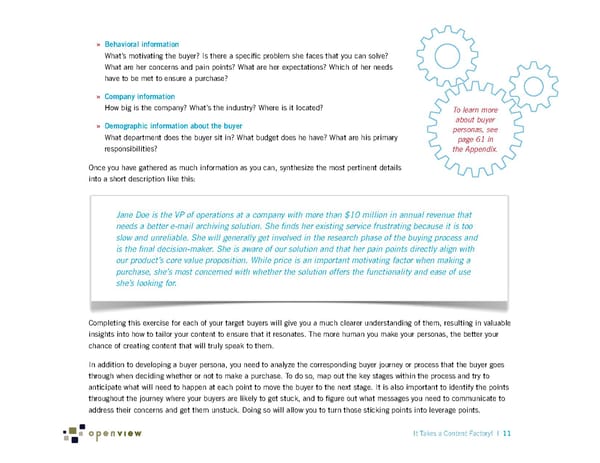» Behavioral information What’s motivating the buyer? Is there a specific problem she faces that you can solve? What are her concerns and pain points? What are her expectations? Which of her needs have to be met to ensure a purchase? » Company information How big is the company? What’s the industry? Where is it located? To learn more » Demographic information about the buyer about buyer personas, see What department does the buyer sit in? What budget does he have? What are his primary page 61 in responsibilities? the Appendix. Once you have gathered as much information as you can, synthesize the most pertinent details into a short description like this: Jane Doe is the VP of operations at a company with more than $10 million in annual revenue that needs a better e-mail archiving solution. She finds her existing service frustrating because it is too slow and unreliable. She will generally get involved in the research phase of the buying process and is the final decision-maker. She is aware of our solution and that her pain points directly align with our product’s core value proposition. While price is an important motivating factor when making a purchase, she’s most concerned with whether the solution offers the functionality and ease of use she’s looking for. Completing this exercise for each of your target buyers will give you a much clearer understanding of them, resulting in valuable insights into how to tailor your content to ensure that it resonates. The more human you make your personas, the better your chance of creating content that will truly speak to them. In addition to developing a buyer persona, you need to analyze the corresponding buyer journey or process that the buyer goes through when deciding whether or not to make a purchase. To do so, map out the key stages within the process and try to anticipate what will need to happen at each point to move the buyer to the next stage. It is also important to identify the points throughout the journey where your buyers are likely to get stuck, and to figure out what messages you need to communicate to address their concerns and get them unstuck. Doing so will allow you to turn those sticking points into leverage points. It Takes a Content Factory! | 11
 It Takes a Content Factory! Page 16 Page 18
It Takes a Content Factory! Page 16 Page 18